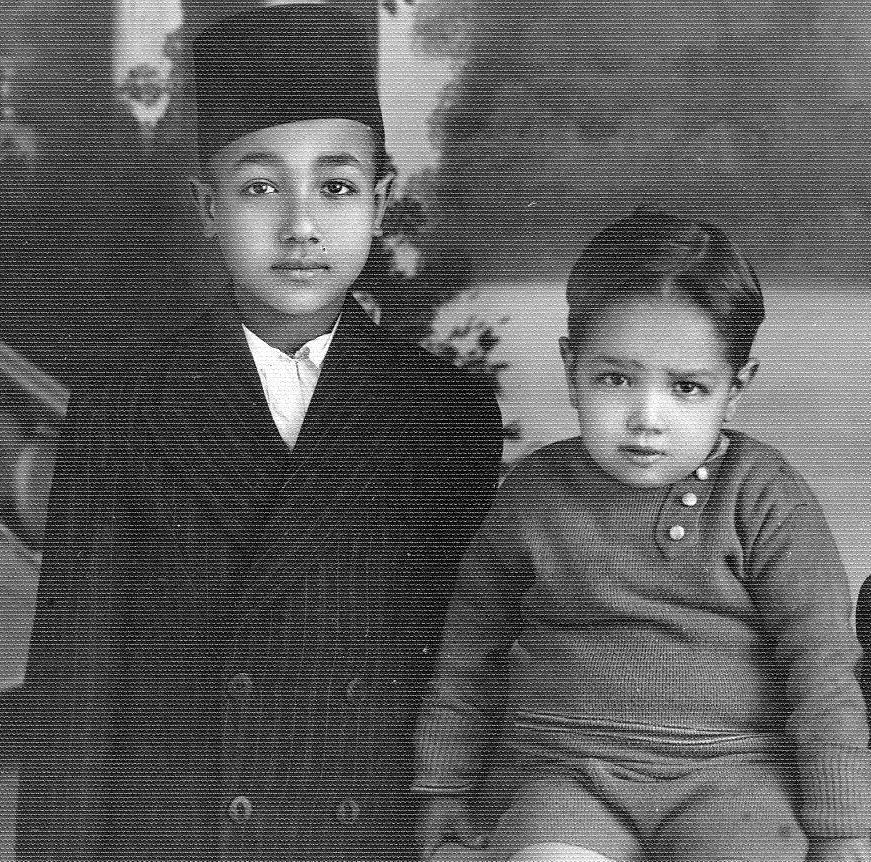
Egyptian Traditional Garments: Headwear--Fez/Tarboosh

Figure 1.--We see three Egyptian brothers in 1937. The two older boys are wearing Western suits with fezes. Here are two of the boys. Their father probably was a civil servant. Ironically the fez was inrtroduced by Sultan Mahmud II
as a modernizing reform but by the time the portrait was taken had become a symbol of backward Middle Eastern society.
|
|
We are not entirely sure about the origns of the fez. It made have originlly been a Byzantine garment which became popular in the Balkans where various Slavs, mostly Bosniaks and Serbs. We also notice refernces to Chechnya in the Cucasuses.
The fez is a part of the traditional clothing of Cyprus, although just when they began and the origins are unclear. e note references to ancient headwear, but this made refer to Bzantuine times. Greek headwear, The name fez of couese comes from the Moroccan city. We know that was a center of fez production, but again we do not know just when that began. The term 'fez' reopresents the fact that the headwear was produced there, not that it originated there. Europeans apparently came in contact with the fez there. While the origins of the fez is murky at best, we do have confirmed information about Egyptian fezes. Ottoman Sultan Mahmud II (1808-39) suppressed the Janissaries and began sweeping reforms of his backward military (1826). He had his modernized military adopt Western style uniforms and to add a destinctive headwear, chose a red fez which he seems to have connected with Checheya. The Sultan pleased with the fez, ordered his civil officials to wear a plain fez. At the same time he banned the traditionsl turbans. [Jirousek] He wanted to promote the fez the wider Ottomamn populace and he succeed to a substantial degree. The Sultan promoted the fez as a egalitarian measure. It tore away at the sumptuary laws that for years denoted rank, religion, and occupation. These laws allowed prosperous non-Muslims to express their wealth in competition with Muslims. Tradesmen and artisans generally did not choose to wear the fez. It became, however, a symbol of modernity throughout the Middle East in Ottomon controlled areas and even in Persia (modern Iran), the rival regionl power. The fez was the beginning of a process that would lead to the Tanzimat reforms. The Sultan's action led to the doption of the fez in Egypt. Egypt was no longer an Ottoman province, but the Sultan still had considerable prestige. The fez in Egypt this was called a 'tarboosh'. Mohammed Ali made the tarboosh a part of the Egyptian military uniform. We begin to see European garments (19th century). We see this in the Ottoman court and among Egyptian officials and elite, especially after the establishment of the British Protectorate. Civil servants and members of the ruling intelligentsia could be seen in Egypt in European style clothing. But the one Western garment not adopted was headwear. And as turbans did not fit with Western dress. We see the turban being worn. The same was the case in the Ottoman Empire. This continued until after World War II. And we see Eguptian boys wearing the fez as well. Age was not at play here. The boys who wore fezes were boys whose fathers wore fezes. This only changed with the 1952 revolution that ousted King Farouk. The military commnders involved in the 1952 revolution did away with the fez. The Egyptians did not wear the Arab kufeya and `igal, except for some of the Bedouin.
Sources
Jirousek, Charlotte. "Islamic Clothing". Encyclopedia of Islam. (New York: Macmillan, 2005).
>br>
HBC

HBC Chronolgy Pages in the Boys' Historical Web Site:
[The 1880s]
[The 1890s]
[The 1900s]
[The 1910s]
[The 1920s]
[The 1930s]
[The 1940s]
[The 1930s]
[The 1940s]
[The 1950s]
[The 1960s]
[The 1970s]
[The 1980s]
Related Style Pages in the Boys' Historical Web Site
[Smocks]
[Long pants suits]
[Knicker suits]
[Short pants suits]
[Socks]
[Eton suits]
[Jacket and trousers]
[Blazer]
[School sandals]
[School smocks]
[Sailor suits]
[Pinafores]
[Long stockings]
Navigate the Boys' Historical Clothing Web Page
[Return to the Main Egyptian traditional garment page]
[Return to the Main Egyptian garment page]
[Return to the Main Egyptian page]
[Introduction]
[Activities]
[Biographies]
[Chronology]
[Clothing styles]
[Countries]
[Bibliographies]
[Contributions]
[FAQs]
[Glossaries]
[Images]
[Registration]
[Tools]
[Boys' Clothing Home]
Created: 11:11 PM 12/8/2018
Last updated: 11:11 PM 12/8/2018



